After a gala evening in the 236th Milan football derby, Inter are close to their first Champions League final since the last triumph 13 years ago.
In the first leg of the semi-finals, coach Simone Inzaghi‘s team didn’t give city rivals AC Milan a chance and, with a 2-0 win, created an excellent starting position for the second duel on May, 16th. Edin Džeko and Henrikh Mkhitaryan scored for the well-deserved victory, which could have been even better.
In this tactical analysis, we will take a look at both teams’ tactics. As we will see in this analysis, Milan did have more possession but Inter’s defensive shape was a massive factor in the final scoreline.
Lineups
In the Champions League semi-final against Inter, AC Milan lined up a 4-2-3-1 with Mike Maignan in goal. The back four consisted of Davide Calabria on the right, who was later replaced by Pierre Kalulu in the 82nd minute, Simon Kjær and Fikayo Tomori in the centre and Theo Hernandez on the left.
In midfield, Sandro Tonali and Rade Krunić played as the holding midfielders, with Alexis Saelemaekers and Ismael Bennacer playing as the wide midfielders. Bennacer was substituted with an injury in the 18th minute for Junior Messias. Brahim Diaz played in the attacking midfield role, just behind Olivier Giroud, who played as the lone striker. Origi came on for Saelemaekers in the 60th minute, while Tommaso Pobega replaced Diaz in the 82nd minute.
Inter lined up a 5-3-2 with Andre Onana in goal, protected by a back three of Matteo Darmian, Francesco Acerbi, and Alessandro Bastoni. The wing-backs were Denzel Dumfries and Federico Dimarco, who was later replaced by Stefan de Vrij. In midfield, Nico Barella was accompanied by Hakan Çalhanoğlu, who was substituted by Roberto Gagliardini in the 78th minute, as well as Henrikh Mkhitaryan, who made way for Marcelo Brozović in the 63rd minute. Up front, Lautaro Martinez was partnered with Edin Džeko, who was replaced by Romelu Lukaku in the 70th minute.
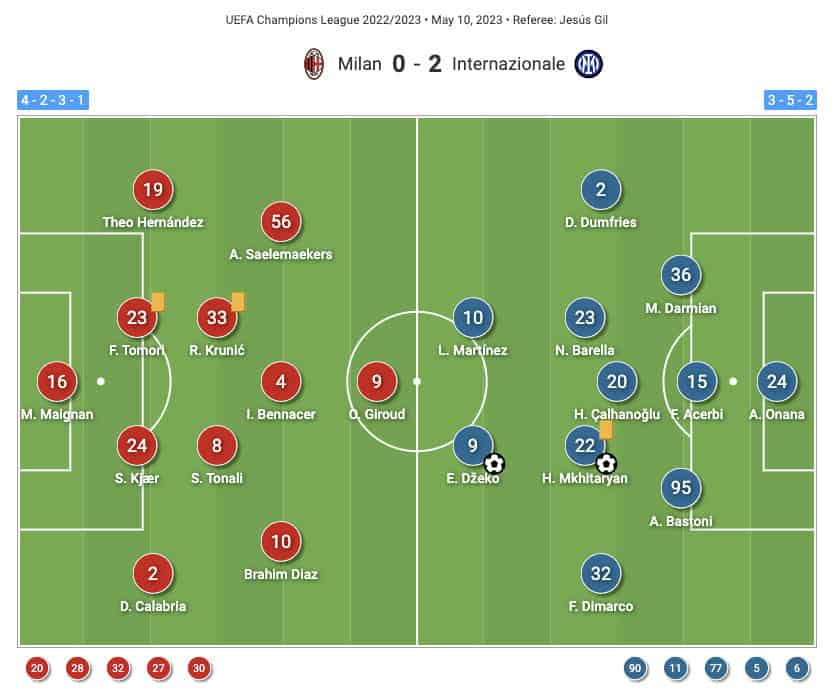
With Rafael Leão injured, the substitution options for Milan were limited, while Inter could bring in players like Lukaku and Brozović in the second half.
AC Milan’s build-up play
During the match, Inter’s shape was focused on limiting AC Milan’s play through the centre. Their midfielders didn’t venture forward as much as usual and had fewer touches on the ball. From goal-kicks, Kjær and Tomori often dropped to either side of the goalkeeper, with a double pivot in support, Giroud up front, and Diaz ready to pick up a second ball after Bennacer had gone off.
In the first half, Inter’s press was aggressive, with Martinez and Džeko perfectly positioned to press the centre-backs, backed up by the midfield. Çalhanoğlu was able to mark Diaz, who was operating between the lines. Inter’s wingbacks were also given the freedom to push higher up the pitch and challenge the AC Milan fullbacks, thanks to their wider back three.
In this way, Inter registered 5 high regains, 11 counterpressing recoveries (5 seconds after a possession loss) and 8 dangerous ball recoveries (leading to a shot within 20 seconds) during the match.
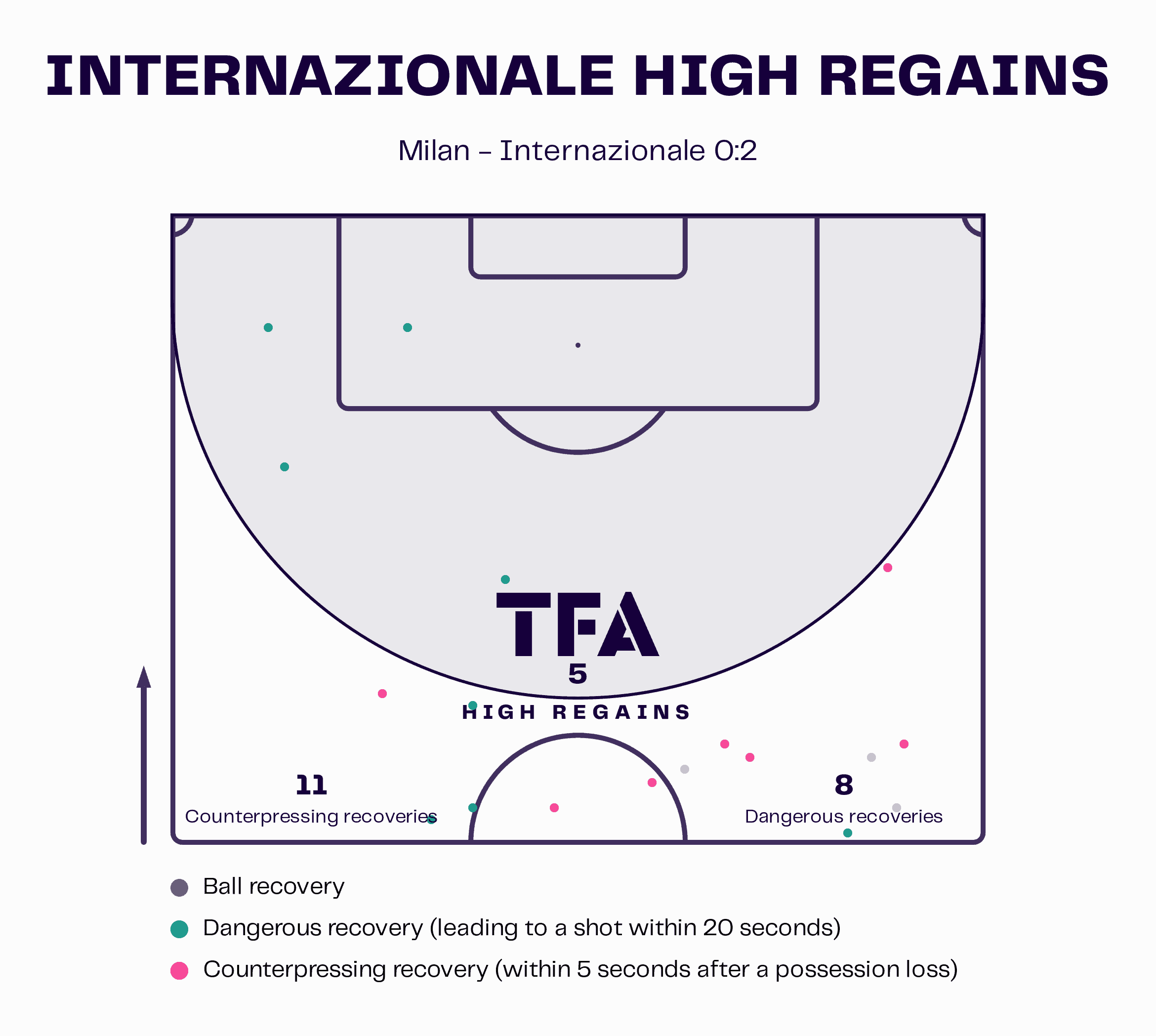
This provided both qualitative and numerical superiority for Inter, as they remained compact and didn’t allow any central room. Whenever the ball was passed wide, two Inter players would challenge the ball. Inter Milan’s pressing structure was perfect with the high wingbacks and forwards ready to press the centre-backs, backed up by the midfield.
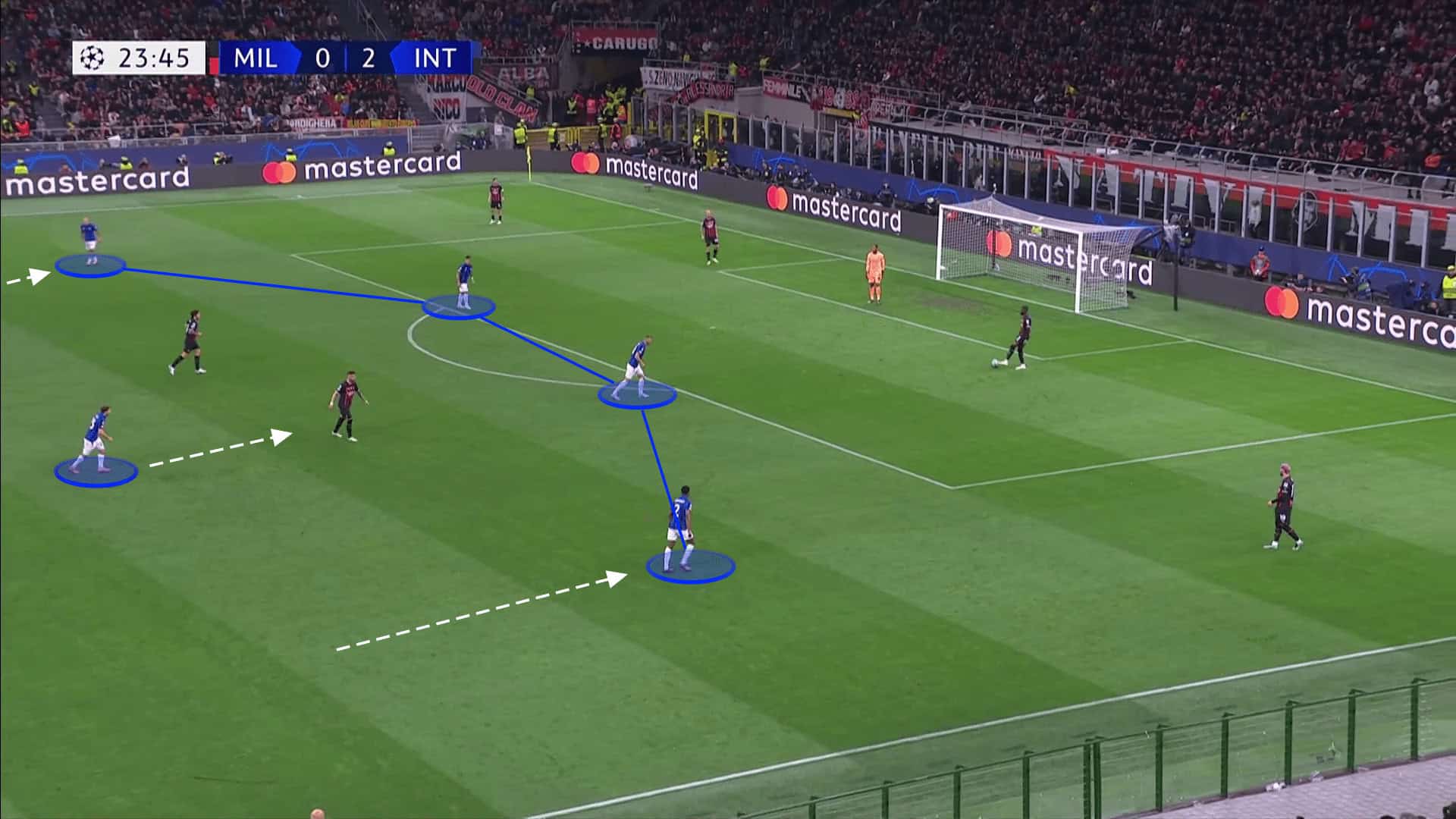
In some scenarios, one of the forwards would cut off one of the passing lanes to a centre-back, while the other did the same on the remaining centre-back. This would force a long ball to find Giroud and allow Inter to get numbers around him for the second ball.
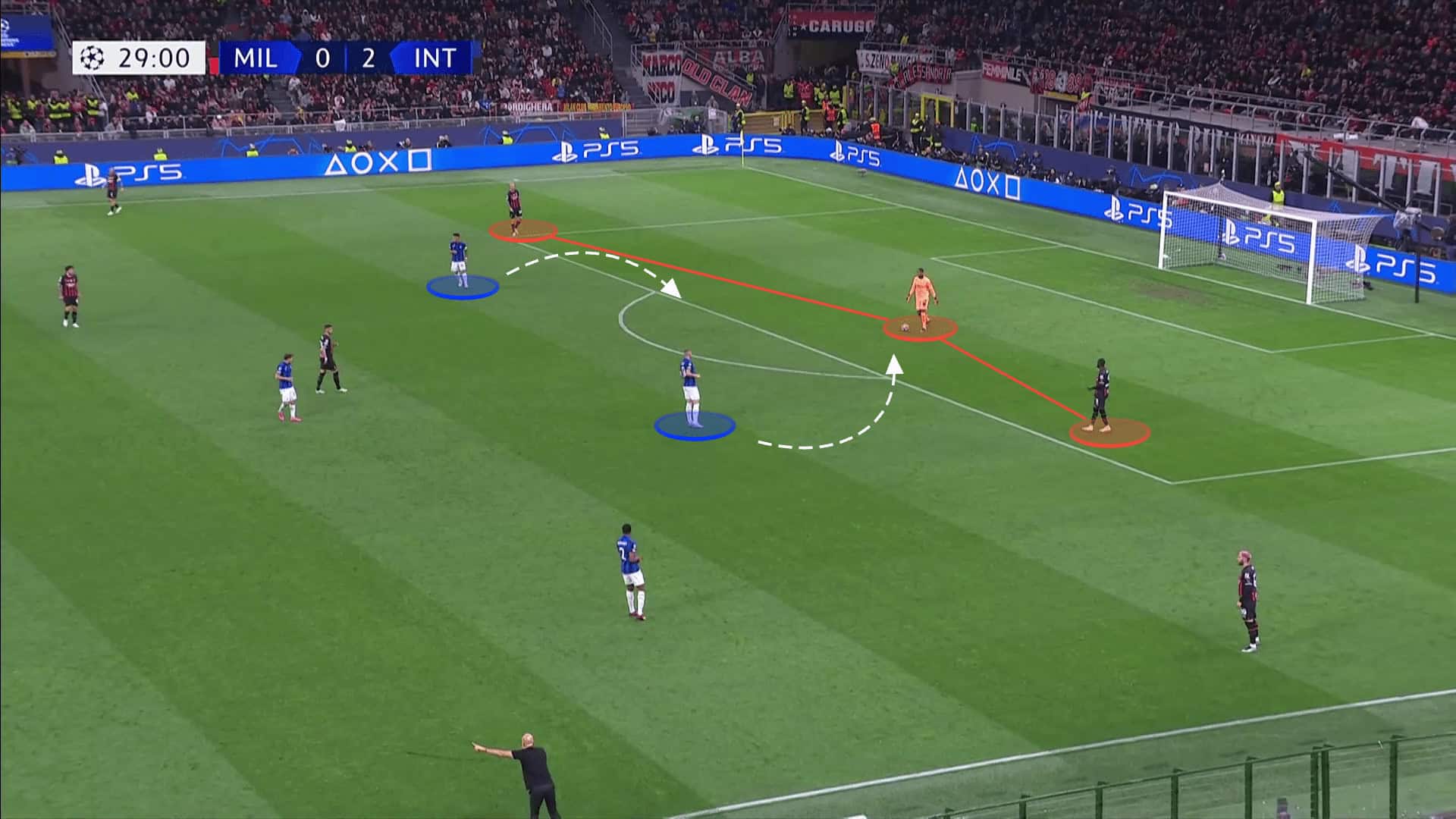
Džeko made a curved run onto the goalkeeper in this situation, forcing him to play long. This played heavily into a goal, as Martinez pressed from out to in, keeping Kjær from being accessed while Džeko was ready to spring onto Tomori, forcing him to play long.
Space in midfield
AC Milan struggled to penetrate Inter’s compact midfield and forward 3-2 sub-structure, which left little space between the backline and the second line. The only option for AC Milan was to play direct and vertically, but losing the ball in the middle third could lead to a costly outcome.
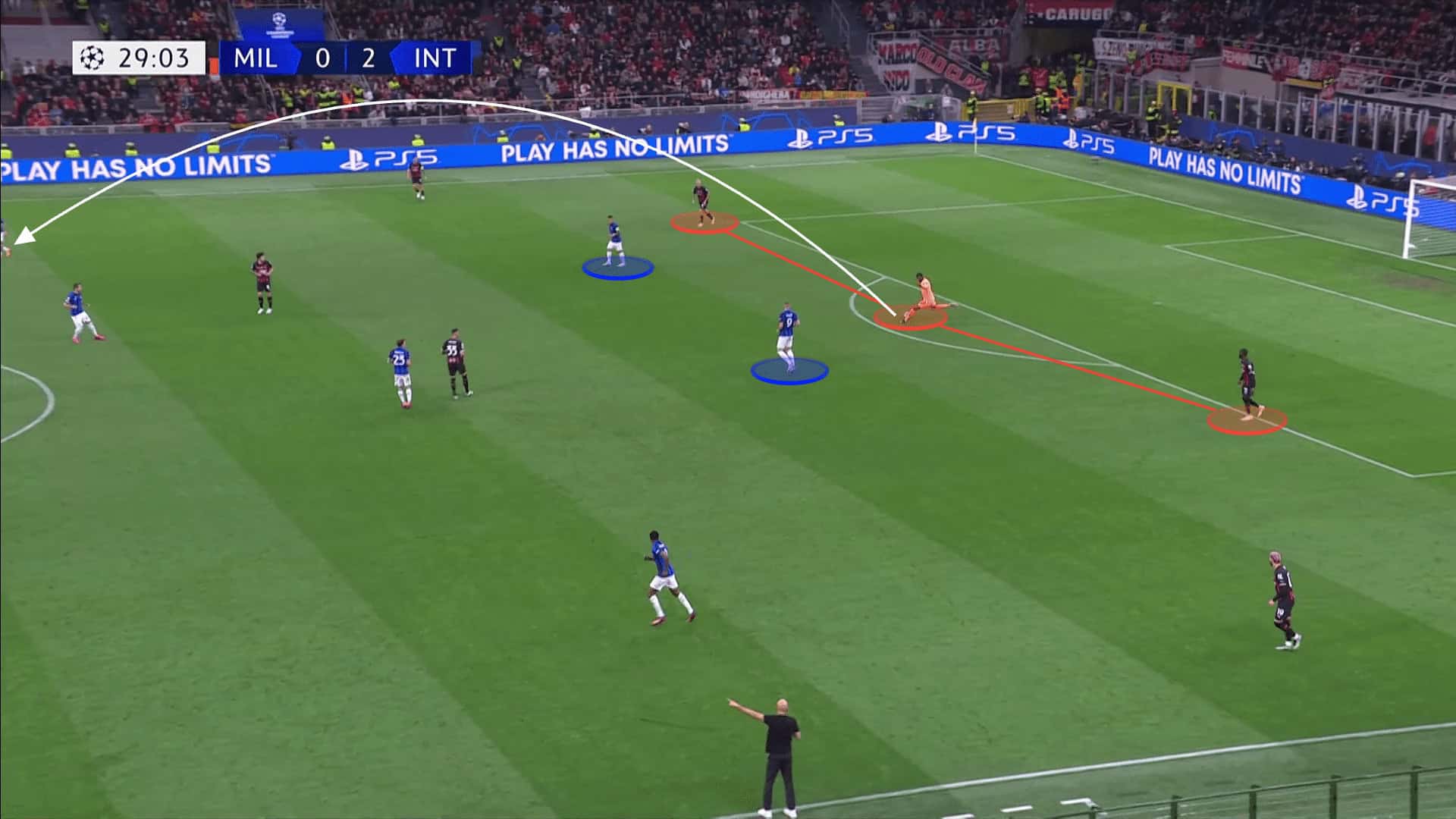
Inter’s defensive set-up caused problems for AC Milan as they often had 5v2 in central areas ready for transitions, and the distances in midfield were significant. Even when AC Milan played long balls to Giroud, they had to get numbers around him for the second ball, leaving them vulnerable.
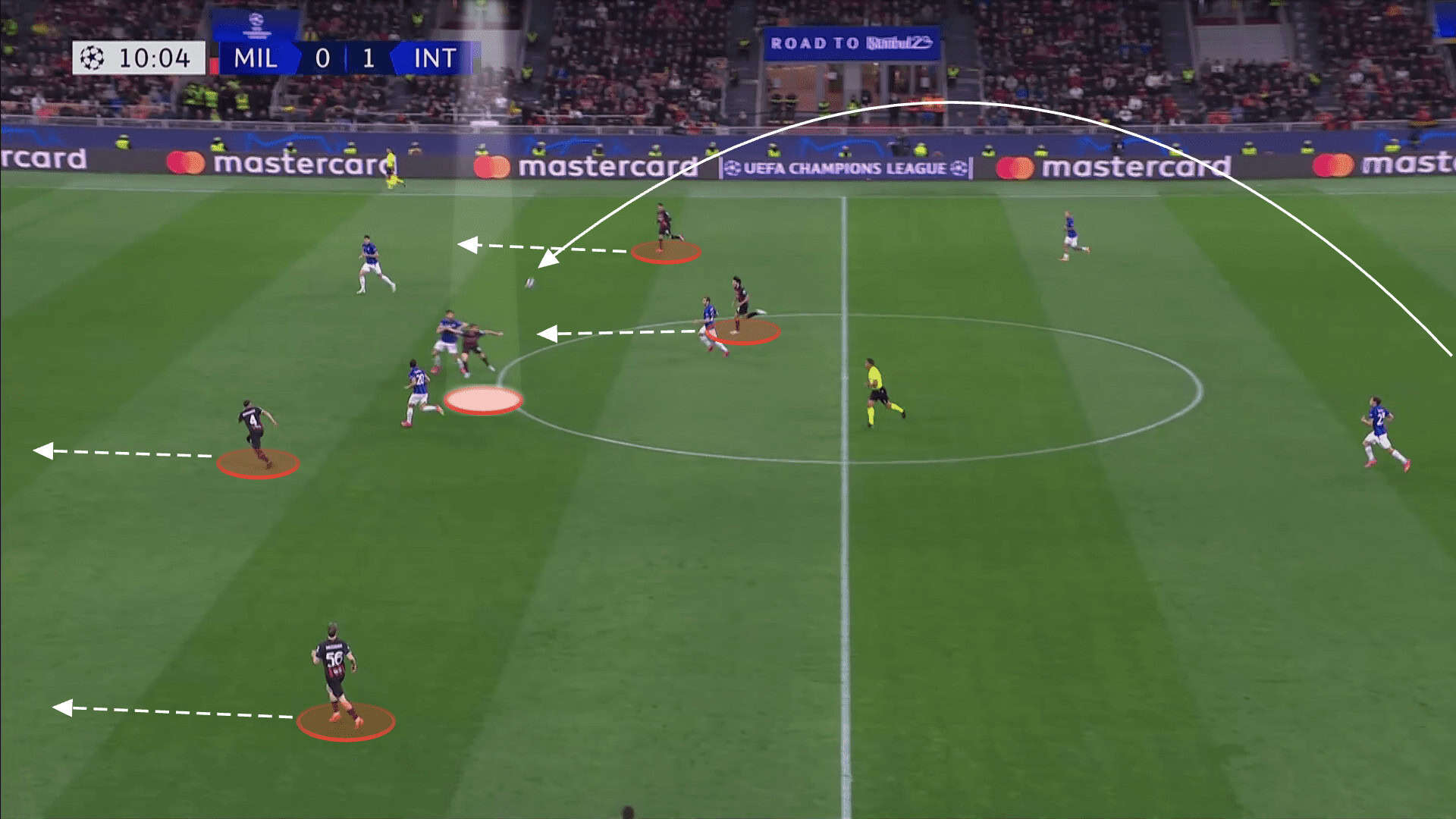
In this instance, Milan failed to get the second ball, leaving only Krunić in a central midfield position. As a result, Di Marco was able to make a run in behind and score, taking advantage of the gap in midfield.
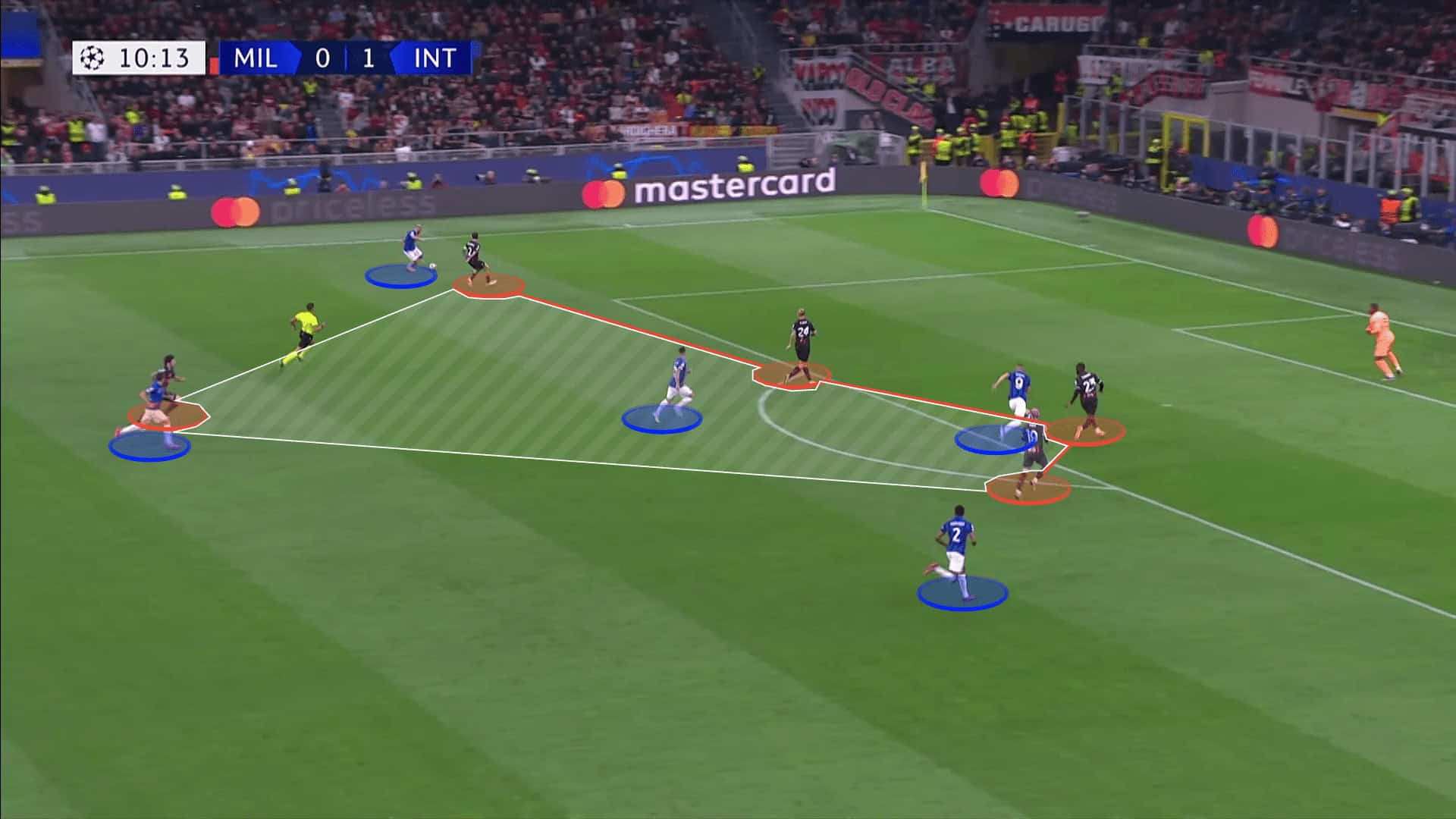
Less risk
The primary objective of Inter during open play was to prevent AC Milan from playing through the centre. With only two centre-backs during the build-up phase, Inter was positioned perfectly to press man-to-man.
However, the approach was different during the goalkeeping phase. Inter didn’t want to risk having man-to-man situations, particularly with Giroud as a great target man and runners off of him who could exploit any gaps. Since they took the lead early, they didn’t need to take any risks.
The use of the wing backs was more conservative, and they stayed deeper on the wingers to have a genuine back five while defending. This resulted in limited space for AC Milan, with the fullbacks not able to enter the attack much as the centre was still protected.
In this scenario, the central midfielders and forwards drop deep, leaving a lot of space for Hernandez to exploit. However, Inter remained proactive and did not allow AC Milan’s fullbacks to receive the ball easily, continuing to press them. When Hernandez received the ball in deeper areas, instead of Dumfries pushing up, Barella would move to press the fullback while Çalhanoğlu and Mkhitaryan would cover the midfield pivots.
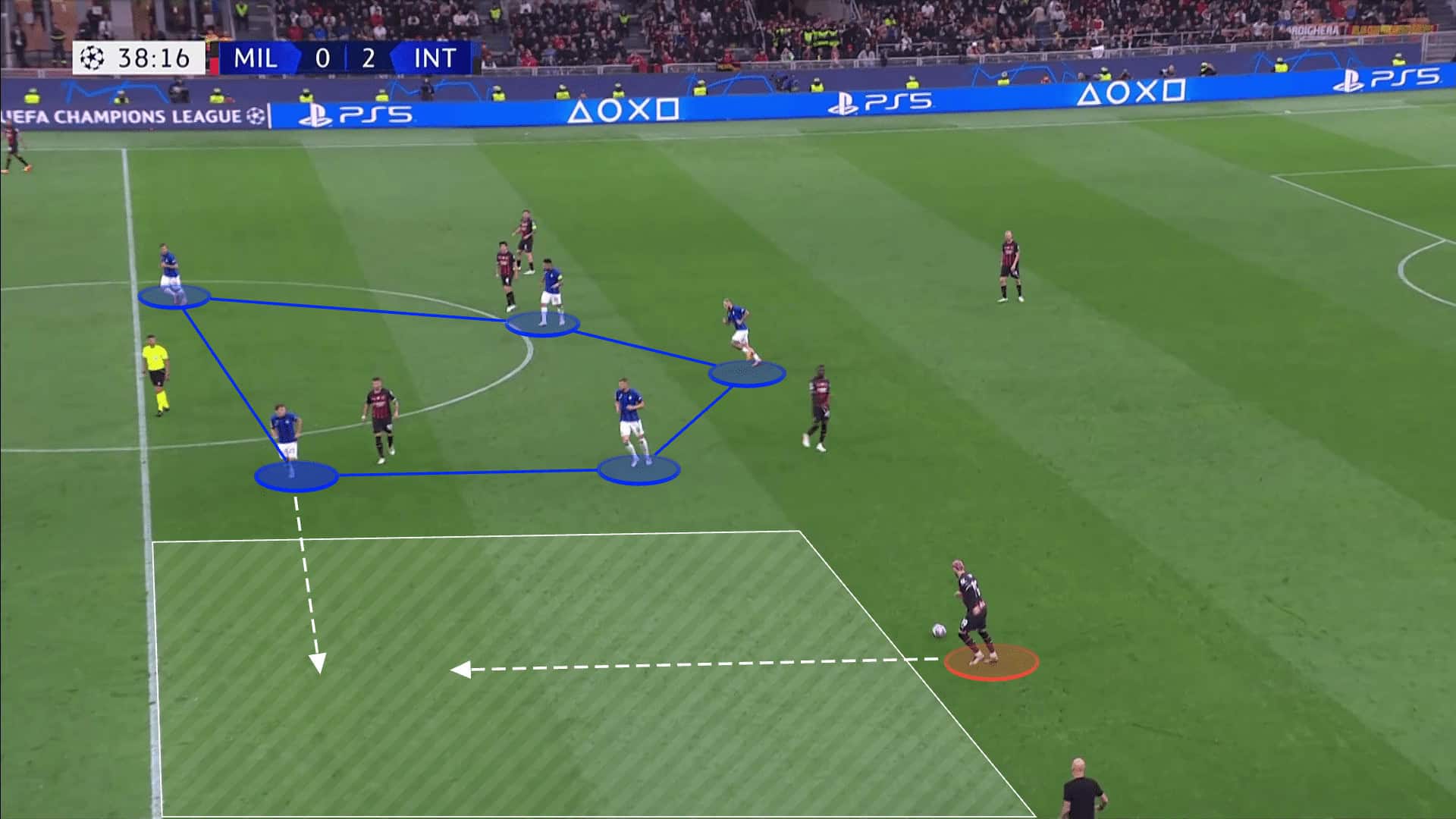
Although AC Milan had a numerical advantage of 3v2 in the midfield, Diaz between the lines could be marked since Inter had a 3v1 advantage against Giroud.
Darmian was eager to push up the pitch in these scenarios, making it hard for AC Milan to advance with central options blocked. In this situation, Hernandez had space at first, but as soon as he tried to move forward, Barella quickly closed him down. Diaz was positioned between the lines, but he was already marked, leaving no easy option for progression.
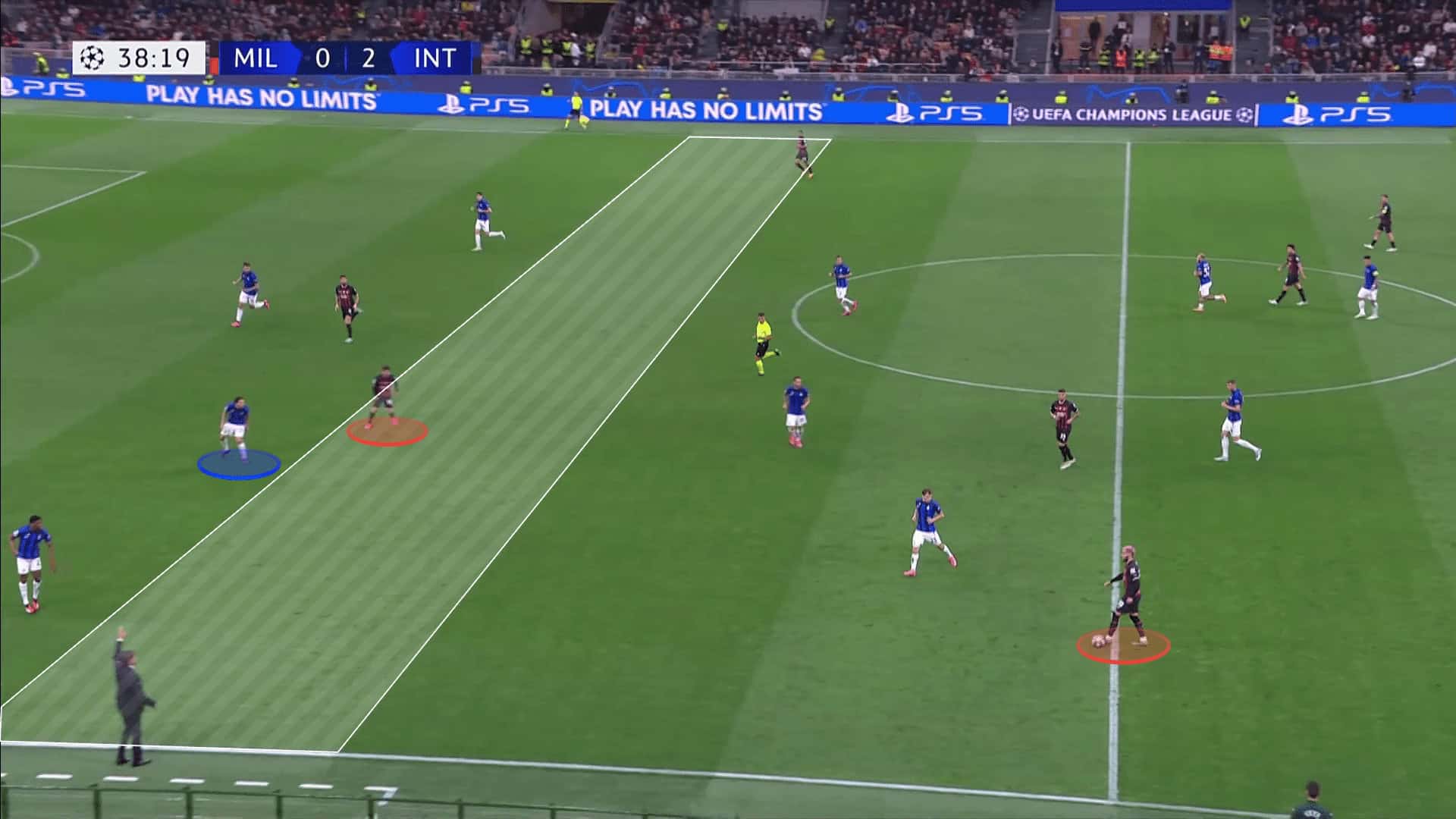
Chances for Milan
The general principle on the right-hand side remained the same as on the left. When Calabria received the ball, the objective was to have Mkhitaryan move out wide to shift seamlessly.
However, unlike Barella, Mkhitaryan lacked the consistency to move from out to in throughout the game, resulting in him not always being able to make it across. Consequently, AC Milan had more success down the right-hand side, with more shots taken from this area than the left.
The problem arose when Mkhitaryan was unable to cover, and Di Marco was forced to push up, dragging out Bastoni, who is less of a natural wide defender than Darmian. Diaz also operated in these areas, making it difficult for Mkhitaryan to cover him. As a result, AC Milan had an overload on the right-hand side at times and could access dangerous zones.
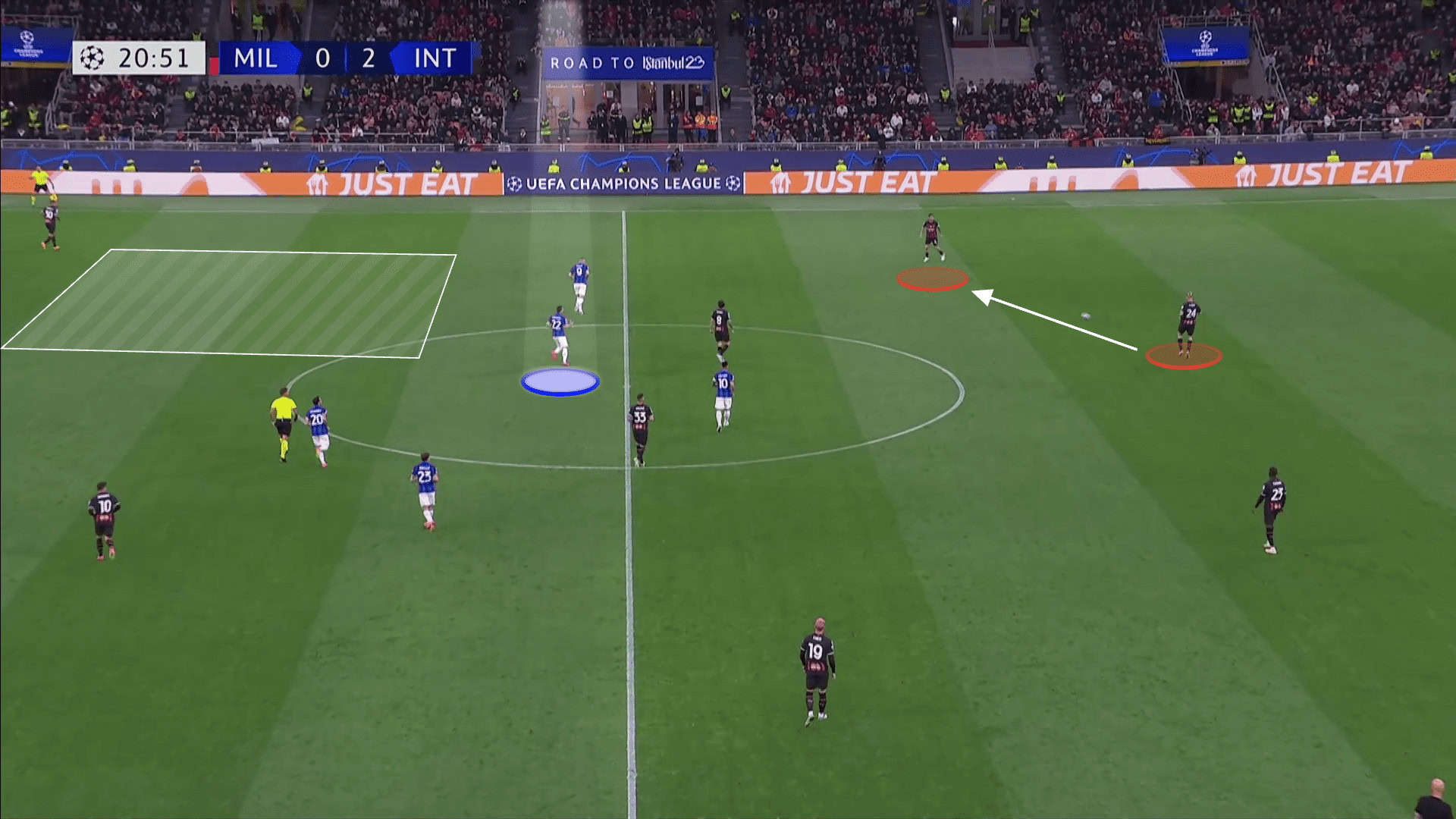
As the match progressed and with Inter leading, they adopted a more conservative approach with much less pressing. They were no longer pressing the centre-backs with their two forwards and instead focused on cutting out the double pivot. This often resulted in a 5v2 scenario, making it very difficult for Milan to make any progress.
Looking at the heatmap of AC Milan from their Champions League semifinal against Inter, it’s evident that Inter’s pressing and defensive structure forced Milan to play out wide on the wings instead of playing in the centre. The heatmap clearly shows a concentration of AC Milan’s activity on the wings, especially the left-hand side, with much less activity in the centre of the pitch. This is likely due to Inter’s aggressive pressing and later on the cutting of the double pivot in the centre of the pitch. Inter were able to cut off Milan’s passing lanes and forced them to play out to the wings. By doing this, Inter was able to limit Milan’s attacking threat and keep them from creating clear-cut chances in front of goal.
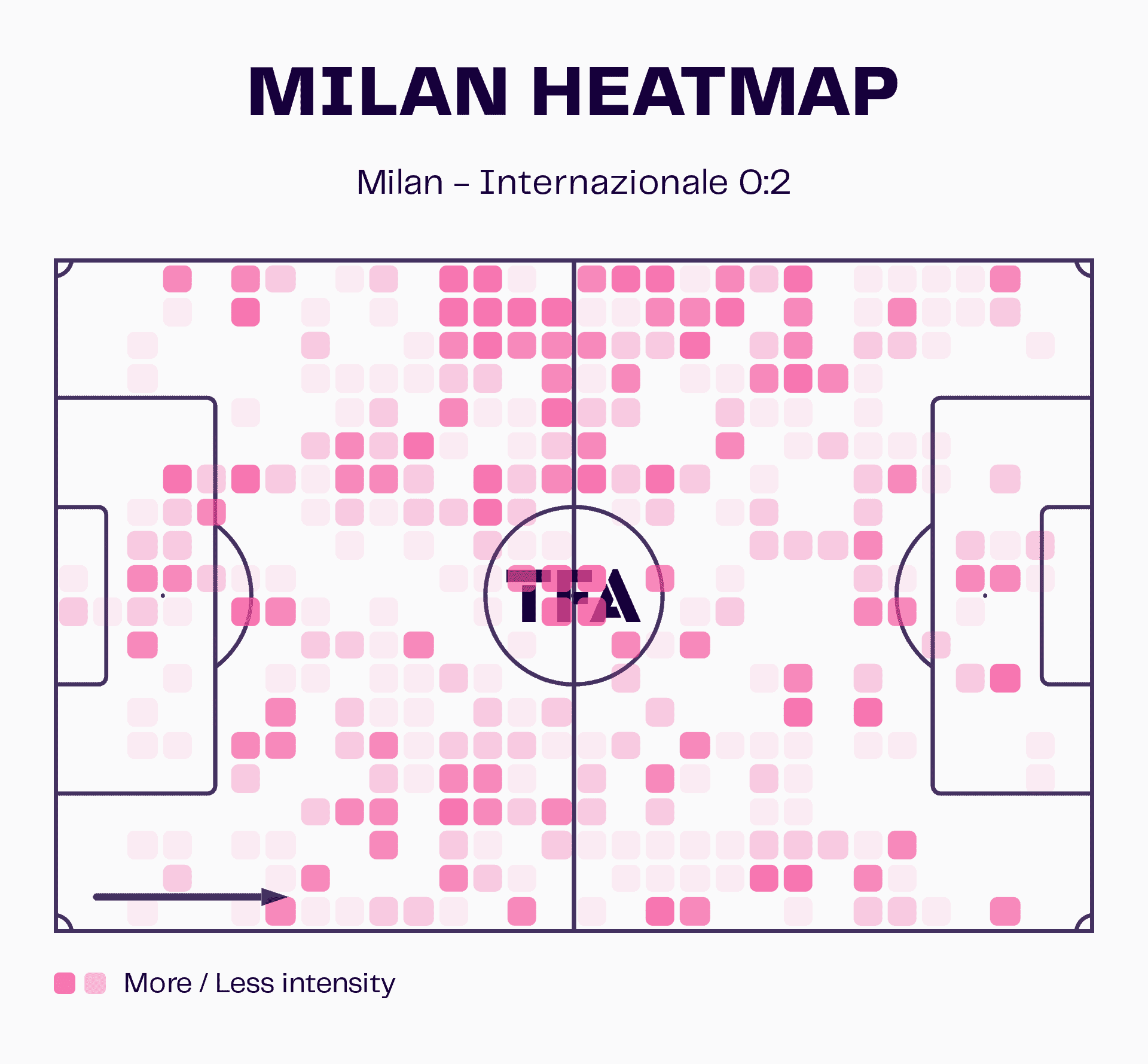
Despite Inter’s reduced pressing, Milan still managed to create some promising situations higher up the pitch, particularly when Origi came on and showed his willingness to take on his marker. Saelemaekers also had some success, but ultimately, it was not enough for Milan to make a comeback in the match.
Conclusion
In the upcoming second leg, AC Milan will face an uphill battle, especially since they were without their difference-maker Rafael Leão due to injury. Leão has the ability to break lines and get past challenges effortlessly, and his absence changed Inter’s game plan. If Leão is in the lineup, Inter’s focus would shift towards him, opening up space for his teammates. Therefore, AC Milan will be hoping for Leão’s return to form to give them a fighting chance in the second leg.
Inzaghi’s pressing tactics made it challenging for AC Milan to possess the ball and create clear-cut chances. Pioli’s side struggled to break through Inter’s defence. However, suppose AC Milan can drop back deeper, entice Inter to push forward, play more direct, win aerial battles, and exploit the space behind Inter’s defence, they might be able to create opportunities in the second leg.





Comments